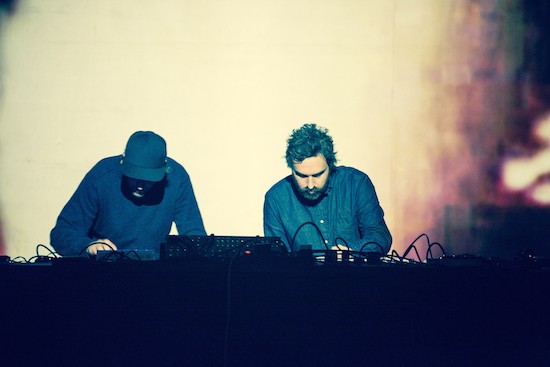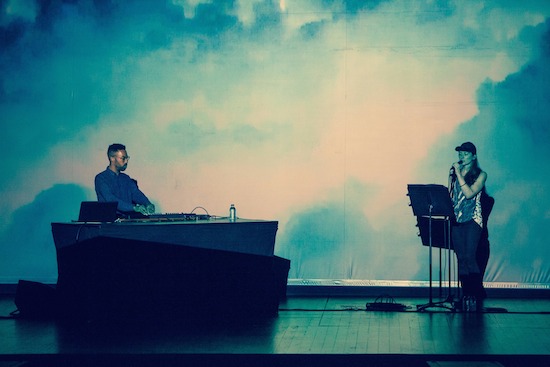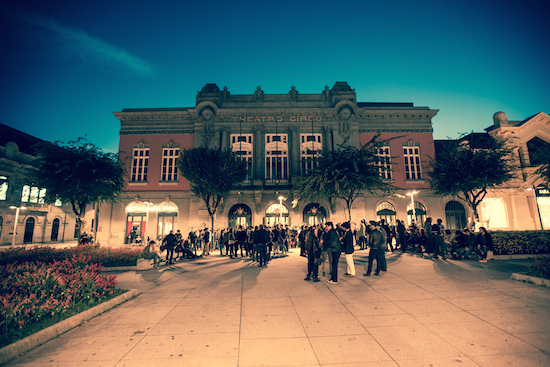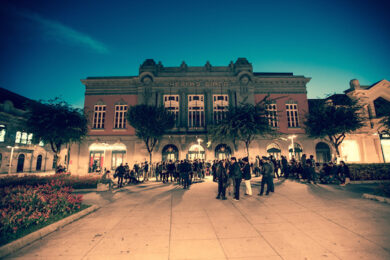It’s Sunday evening, and in the kind of room that looks like it once hosted clandestine, candle-lit meetings of curiously robed, secret societies – crumbling, powdery walls, unevenly worn, wooden floorboards, peeling window shutters, all accessed only by a smooth, stone staircase – I find myself sitting next to a multi-disciplined Polish artist called Anna Zaradny. I’ve already knocked her (fortunately empty) plate to the floor, and been forced to admit humbly that I wasn’t able to see her performance on the opening night of Semibreve, the Portuguese festival we’ve both been attending in the city of Braga, since I only arrived the following afternoon. As I awkwardly explain the reason for my presence – to write about something whose brief is billed un-self-consciously as "exploratory music and digital arts"– she studies me suspiciously. Her look becomes no less skeptical as I concede that I’m generally more fluent in discussions of ’80s pop and ’90s indie rock than in the language of the 21st century avant-garde.
Nonetheless, I continue nervously, my horizons were so successfully broadened last year during this brave, far-sighted event that I wanted to see if I could repeat that. Also, I add, I hoped to learn more about what it is that does and doesn’t appeal to me in this experimental forum, and, indeed, why that is. I’ve now reached the conclusion, I announce courageously, that it’s all about narrative. When faced by humourless technicians sliding faders, tapping Macbooks and twisting knobs, my hackles are raised not so much by the idea that "I could do that too" so much as a fear that "they have absolutely no idea where they’re going with this". If I want to watch someone press buttons aimlessly, I’ll visit Carphone Warehouse.
In my case, Semibreve gets underway on Friday evening with @C. Their presence on the main stage of the Theatro Circo – a lavish, well appointed venue which opened 99 years ago on the Avenida da Liberdade, a grand pedestrian street abundant with colourful flowerbeds – is actually due to a last minute cancellation by Karen Gwyer, who’s nursing a sick child back at home. Promoted from the smaller studio downstairs, these two shadowy Portuguese men struggle to fill a capacious space best served by visual accompaniment. They do their best to compensate for what’s lacking with a soundtrack of found sounds and field recordings, beginning with the buzz of insects and the spatter of a jungle rainstorm. Is this Vietnam, I wonder? No: those are didgeridoos. They go on to construct an underbelly of threatening drones, interrupted by bursts of static, what sound like brief samples of R2D2 and a gurgling plughole. Later on, a throbbing pulse threatens a beat – but none comes. Instead, their shapeless soundscapes invite colourful comparisons: a flatulent Casper The Friendly Ghost, rubbing and popping balloons; the slow motion death, by torture, of a wind-up toy orchestra; a slasher movie set in a New Age candle shop. Any obvious association between the various sonic components is hard to detect, but the duo are, no doubt, great company at dinner parties. Thom Yorke should invite them over. I probably won’t attend.
In the smaller auditorium downstairs, stepping up to the plate at very short notice, Mark Fell has agreed to exhume his Multiplicity project from 2010. Completely destroying dance music’s four to the floor obsession, the sheer kinetic energy of what he creates provides an – albeit dizzying – sense of direction missing from what we heard upstairs. Though Fell’s landscape is all about interlocking grooves falling apart, tracks speeding up and then decelerating, he’s able to build this calculatedly staggering, alien clamour up to a fierce assault before it deflates into a ticklish twitch. You can almost feel the maths here: at times it’s like techno’s take on Eno’s Discreet Music, its multiple layers weaving around one another, its beats subject to formulae. At other times it sounds like a malfunctioning pinball machine, or, for variety, a Space Invaders game with a Gabba soundtrack.
Moments before Fell’s actually finished, he throws his cables into his bag, tossing it over his shoulder and walking offstage. Maybe he’s in a rush to return to the main theatre, where Sweden’s Roll The Dice prove to be a relative walk in the park. It’s a walk in an unlit park by night – with rumours rife of serial killers, rabid dogs, suicide bombers and an invisible crack in the time space continuum that provides a rapid descent into hell – but it’s still a walk in the park in comparison. For starters, Malcolm Pardon, who works as a film composer, and his companion, Peder Mannerfelt (aka The Subliminal Kid, and also a member of Fever Ray) have no bone to pick with structure. What unfolds is colossal, and entirely suits these two heavily bearded Vikings. As high definition images of spectacular landscapes are manipulated and beamed behind them, they lay down concrete slabs of repetitive melody via a bank of analogue synths, keyboards and other assorted, vintage machinery. These swell from John Carpenter minimalist tension via Wagnerian crescendos to huge swathes of sound, not unlike the manner in which Michael Gira conducts Swans, were he to collaborate with Front 242. In spite of this, there’s an unaccountable lack of resolution to the show: their ‘songs’ keep ramping up the tension, but they never seem to reach their peak. In a sense, though, it adds to the terror: even afterwards, on Braga’s quaint, quiet streets, we’re still strolling through that park.

Semibreve was founded in 2011, and, despite its small scale and slightly obscure location – Braga is a 45 minute drive from Porto, and only Portugal’s seventh largest city – it’s established itself swiftly as an adventurous showcase. Mouse On Mars, Jon Hopkins, Vladislav Delay and Ben Frost have all performed here, alongside acts with more specialist appeal. Last year, The Haxan Cloak bored a hole straight through my skull into my mind’s darkest matter, making me, in some strange way, more susceptible to all but the most esoteric acts on offer. Much of the line-up this year is unfamiliar to me: I know Plaid, patten, Mark Fell and Roll The Dice, but Ryoichi Kurokawa? Thomas Ankersmit? Anna Zaradny herself? These names are daunting: my lack of knowledge of what they do, why they do it, and what it all means, belittle my confidence in my own ability to comprehend their work. Still, I’m determined to find a way in.
Of course, one ‘way in’ is Braga itself, whose appearance is as elegantly wasted as Keith Richards’. Many of the buildings in its old town centre are visibly falling apart, but they’re still reminders of a fabulous past. Their facades may be colourfully tiled, but, from time to time, when I raise my eyes, I notice how their upper storeys are abandoned, their windows boarded up, their balconies decrepit. Meanwhile, along winding, cobbled lanes, dusty storefront windows containing relics of former times – yellowing books, football boots with plastic, screw-in studs, sun dresses that no one under 70 would wear – are overseen by ageing, stout women in fading, billowing dresses. Along the main streets, too, portly men with ornamental moustaches stroll like Mafiosi, their arms tucked behind their backs, their blazers immaculate, their trousers cavalry red, rusty brown or Pastel De Nata yellow.
It’s not all about nostalgia, but time seems to pass at a slower pace in Braga, and, when confronted with challenges, the less frantic one’s mental state, the easier it is to process them. Though Semibreve’s setting and content might seem at odds – perhaps that’s why, before each show, the lights in the vast theatre are lowered, even onstage, so that all that exists is the performance – this is in fact an exquisite opportunity to enjoy such cerebral activities. Screeching howls of eardrum-shredding cacophony amplified by a battered, beer-soaked PA in a cramped, musty basement? No, thank you. Squealing bursts of nosebleed noise and giant projections of eerily abstract, constantly shifting shapes in an auditorium fit for an emperor? Well, go on then: I don’t mind if I do, especially if you’re going to allow me first to feast on a delicatessen’s worth of impossibly cheap food and drink in temperatures you’d be lucky to find in midsummer Britain. Seriously: I recommend it. Is that a palm tree over there?
On the afternoon of the second day, a small group gathers in the timeworn room where, the following evening, I will discuss purpose and narrative with Zaradny. It’s situated above 100ª Página, a bookshop in whose café garden I first met her soon after I arrived.
I watch Pierce Warnecke from the doorway of the bookshop’s upper chamber, the only space left from which to see anything. His macro photography of fauna and rock, projected onto the opposite wall with interspersed imagery filmed from a seemingly out of control toy plane, resonates with the Berlin based American’s treated piano and drones. These pictures of both decay and permanence are finely attuned to the textural qualities of what we’re hearing, as though Warnecke’s gaze is turned to the future, but always present in the moment. Though I’m unable to see (or understand) how he’s composing, this feels like an evocative, calming hour well spent scouting a stony middle ground between @C’s meanderings and Roll The Dice’s momentum – albeit slowed down to a crawl.

Stepping into the inexplicable unknown doesn’t always mean stepping out of one’s comfort zone. Listening to patten, however, does. He’s joined the second night by a vocalist, and though there is some debate as to whether her numb, semi-spoken word delivery – not unlike your mother reading out a shopping list to see if you want to add anything – is some form of artistic statement, it can’t deny the fact that her voice is like a thousand yard stare. Patten himself issues forth a sometimes exhilarating, sometimes impenetrable, patchworked mesh of sound, but, in this context, it’s as nimble as a limping B-boy. From time to time, I’m pleasantly reminded of early 1990s work by Insides and Disco Inferno, yet I’m wholly at a loss as to who might describe this as a "simplified world of ordered purposeful harmony, as microscopic in its exquisite detail as the music of the spheres is vast and expansive in its wonder." (The Wire, since you ask).
Downstairs, I’m tested even further by Thomas Ankersmit. Arriving late, I’m led through pitch black darkness to the first row, where the German sits aside a table filled with what looks like an antique radio set. It soon becomes clear why the seats are available: as he tweaks and prods his machinery to establish a deafening representation of poor digestion, a rumbling, protracted, sub-bass shudder provokes within me an ominous sense of genuine nausea. I grit my teeth and clench my buttocks, but seriously: not only could I do this less painfully with a jar of pickled garlic and a packet of Digestive biscuits, but I’m also, entirely convinced Ankersmit has absolutely no idea where he’s headed. Even if he does, I’m not coming with him. I’m off to the bar, where they sell Super Bock for €1.20 a bottle, and the only place that’s sending me is the urinals.
Back in the theatre, it’s Demdike Stare’s chance to steal the night. Like Roll The Dice the previous evening, the English duo lean heavily on dramatic visuals. Asides from these, their monastic drones are paired with images appropriate for an Eastern European horror movie, all demonic psychedelia, close-ups of eyeballs and representations of what it’s like to have a really bad migraine. At one stage, this could be a Satanic take on Sabres Of Paradise’s ‘Smoke Belch I’, if significantly less uplifting than even that sounds, but at other times it’s as full of paranoia as Haxan Cloak scoring Gravity, were the noise shredded by a distorted PA system. It’s the most energetic performance of the weekend so far, vigorously macabre, and their final track – which blends metal, glam and krautrock as though it’s Suicide covering Spinal Tap – provokes the first whoops and whistles since I arrived. Now we’re really getting somewhere.
In the first floor lobby of the theatre, I watch Zaradny’s Octopus, the installation she’s contributed to the festival, also housed in the Filmoteka arm of Warsaw’s Museum Of Modern Art. I’m heartened to discover that this short, arguably gothic film – which toys with music video tropes applied to a consciously experimental soundtrack – is at once haunting and riveting. Its audio component is made up of a constantly developing labyrinth of industrial hums, submarine blips, dry tapping noises and other disembodied sounds, while its hypnotic visual aspect is provided by ambiguous imagery of strange figures which gradually, disturbingly, reveal themselves to be Zaradny. Though she’d likely baulk at the compliment, it’s the best music video I’ve seen in years. Chris Cunningham could certainly pick up a trick or two.
I arrive at GNRATION and Blackbox, where the post-theatre party is getting underway. I set off to explore the building, a former home to the Portuguese National Republican Guard which has been converted into a spectacular arts and culture centre with studio and office space for creative types. Illuminated corridors are visible from the courtyards, and inside there’s a maze of rooms over four floors, some filled with exhibitions unveiled especially for Semibreve. Furthermore, where once there were bare, metal and concrete walls surrounding the exposed, inner enclosures, now there are plant pots hanging at regular intervals, creating an eye-boggling grid of futuristic yet natural beauty and symmetry. The architects of the building were quoted as saying before it was regenerated that "it has to jump into the arena, go on stage and wear sequins." They designed quite the party dress.
In the small hours, Mark Fell appears in the Blackbox to perform under his Sensate Focus alias, and crowds huddle around the solitary bar before fidgeting arhythmically to his glitch-house. First, though, your correspondent’s ears, need a rest. Raquel Nair, GNRATION’s CEO, guides my companions and me through the installations, and we settle beside a strange contraption where vocalists are invited to sing at opposing ends of a large pipe, propelling a red ball between the two ‘opponents’. I have no idea of the artist’s intentions, but I win the battle against my rival. This is probably because I perform an impeccable, a cappella version of George Michael’s ‘Careless Whisper’. Nair even offers to book me for a show. As I return to the Blackbox afterwards, revelling in my victory, I know Fell’s Sensate Focus simply cannot compare. I’m never going to dance again anyway. Guilty feet have got no rhythm.

It’s approaching 5:00pm on Sunday. I’m kneeling down in the Jardim da Avenida Central, where I’m trying to persuade a small dog to use the walkie-talkie I’m holding under its nose. I’ve spent the last half hour or so wandering around the park, holding the radio at the end of my outstretched arm and sweeping it over the heads of elderly ladies gathered with their grandchildren on benches, or waving it in the faces of kids playing on the amenities outside a nearby McDonalds. I’ve also broadcast excerpts of the weekend’s unofficial anthem, Jennifer Hudson’s ‘Dangerous’ – which is on my iPhone as I may need to review it for another publication, and, because I love it – and have run down the street, bent double, holding the appliance as close to my clicking heels as I can, much to the befuddlement of onlookers.
My interaction with the dog is the most successful of my encounters, because its owner is soon curious enough about my activities to approach me for an explanation. I tell her that everything picked up by my gadget – and about a dozen others, transported elsewhere in the vicinity by other willing apprentices of the avant-garde – is being transmitted back to the room above 100ª Página. There, a small group of dedicated explorers sit in the late afternoon gloom, between speakers spread out around the room, while Serbia’s Lukatoyboy conducts a "collaborative, immersive, multichannel experience", using the various transmissions to form "parallel microlocal realities". Having translated this – "There’s a bunch of overgrown kids like me running around here beaming silly noises up into a room over there where a bunch of hungover scholars have chosen to listen to it all" – I point out that this includes the conversation I’m having with her right now. I can’t help wondering whether this exchange is more interesting to those sitting inside than the Hitler speech that someone found online, or the repeated cries of "Onde está Raquel?" from one of the British writers. Still, as the dog finally barks into my device, I feel proud that nobody can doubt my commitment to a project.
By 6:30pm, I’m back in my seat at the Theatro Circo, where Ryoichi Kurokawa takes to the stage to present Syn, which proves to be the highlight of this memorable weekend. Against an explosive, swiftly metamorphosing background of computer simulated animal etchings and strange, Rorschach-like imagery, he fires off hums, hurrs and hisses that slowly accelerate until we’re pulverised by Aphex Twin style, glitchy melodies blended with the industrialised, slow motion purity of Pan Sonic’s earlier work. His analogue keyboards and the surgically pristine sound he’s conjuring from his more technologically advanced weaponry combine with an assault of cinematic visuals to generate a startling experience. Though it can rarely be described as tuneful, its intent is precisely defined, and, as an example of "exploratory music and digital art", it’s faultless. If anyone I’ve watched this weekend deserves a wider audience, it’s indisputably Kurokawa.
Plaid, who close Semibreve’s activities, have a tough act to follow. At times they offer an almost tropical take on electronica, while at other times they bow to pioneers like Depeche Mode, the Human League and Yazoo. A guitarist – the only one I recall seeing all weekend – adds a gauzy, shoegaze veneer, not unlike Ulrich Schnauss’, to a couple of tracks. Their old school Warp sound is quietly comforting, and their visuals match this, with one song accompanied by a straightforward, story-like video, also the only one I recall seeing over the past few days. In the light of what we experienced an hour earlier with Kurokawa, Plaid are far from as innovative as they once seemed, but they provide a gentle comedown after everything that’s preceded them, just as they’ve proven an inspiration to many who have followed them.
<div class="fb-comments" data-href="http://thequietus.com/articles/16613-festival-report-semibreve-review” data-width="550">



